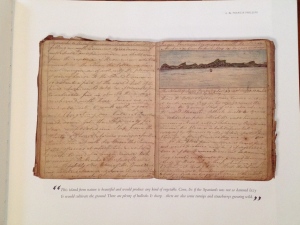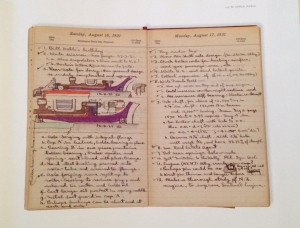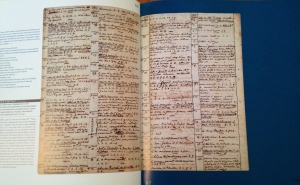
- Heidi Julavits, The Folded Clock: A Diary (Doubleday, 2015)
When I first heard about these two books, which were published almost concurrently earlier this year, I thought about those strange cultural moments when disconnected people become preoccupied with the same issue. I’ve seen “zeitgeist” moments like this before. As a very modest example, when I started writing my dissertation on literary representations of death and mourning, no one was writing about death and mourning but by the time I finished there was an entire school of “mourning studies” and a slate of shiny new books on the topic that I had to account for. I don’t credit myself for having tapped into an intellectual movement but rather consider myself to have been carried along by a wave that was passing through a cultural

- Sarah Manguso, Ongoingness: The End of a Diary (Greywolf Press, 2015)
studies-influenced academic field. Yet, as a result, it’s not an unfamiliar experience for me to witness an uptick in interest in the diary just as I turn to writing about the diary. In fact, when I read about Julavits’ and Manguso’s books, it felt like something of a confirmation: diaries are still relevant! I was very excited to read these books and thought perhaps I would end up assigning one or both in my classes on diaries in the upcoming semester. I read both books early this summer and I suppose it’s evidence of my thinking about them that I have not taken the time to review them until now. Because, I must confess, that my response to both books was disappointment. Granted, I read them as diaries and within the context of the historic diary-keeping tradition that I have been researching and writing about all summer — and perhaps that places an unfair burden on the books. But, as diaries, or as commentary on the diary as a genre, I felt they both fell flat.
Let me discuss each book in turn:
Julavits’ The Folded Clock: A Diary is composed of non-sequential diary entries, each one opening with the phrase “Today I.” Julavits’ writing voice is engaging but often possesses the snarky tone all-too-familiar on social media; in fact, at times, I felt like I was reading a blog post between the cover of a book — and I did not like it. I read books to get away from that quasi-self-deprecating, ironic, critical-observer stance which is so predominant now on social media. I read diaries because they typically employ a more earnest, unironic voice — which is not to say either a more authentic or a more artless voice, because I am well aware that neither term can be easily applied to the diary. But, the diary writing that I prefer, that speaks to me as a reader and a scholar, avoids that brittle separation of the author from the world observed.
That being said, Julavits’ Folded Clock does yield a few interesting points regarding the diary:
• Julavits’ use of the “Today I” phrase to initiate her entries is a practice I’ve seen many diarists use. Not that phrase in particular, but a certain formula that is repeated at the start of every entry. Philippe Lejeune argues that the dated heading is the definitive feature of a diary entry, writing that “setting the date off at the top of the page to indicate the time of writing is a crucial gesture” (80). But, other formulaic prompts play an equally important role, in my observation. Of course, the most common initiating formula I’ve seen across diaries is a summary of the weather, which doesn’t possess much literary interest but clearly does important textual work. I recently read a wonderful nineteenth-century diary in which the author employs a series of prompts, using the same phrase for a while before switching to a new one; hers include “Into …” and “In which ….” One of the most famous diary formulas does not initiate but rather closes a diary entry: Pepy’s “And so to bed.” At any rate, Julavits’ practice places her squarely within the diary tradition. I also found it somewhat infectious; while reading Julavits’ diary, I began writing “Today I” at the start of my own diary entries and I must admit, as far as writing prompts go, it’s a generative one.
• Julavits’ choice to sequence her diary entries in a non-chronological fashion was a smart one. She places an immediate block against the reader’s desire to locate a linear narrative within the diary. This is a problem that many readers of diaries encounter: we long to impose a plot structure on the diary, to identify the “important moments,” to find evidence of foreshadowing, etc. — precisely the kinds of literary techniques that are impossible within the diurnal literary form. Jennifer Sinor writes of the impulse to add order where there is none: “the pull of autobiography to be a whole and interesting story is strong” (54). But Julavits prevents such an organizing imperative by simply removing the linear calendar as a structuring device.
• Despite the fact that the diary does not move from point A to point B in a linear way, Julavits runs up against the problem that many print diaries have: the problem of the ending. To quote Lejeune again, he claims that “the diary is experienced as writing without end” (188). Diaries don’t have an end point — they cannot have a climax + denouement structure unless one is imposed retrospectively (at which point it is not a diary anymore). So, if you are Heidi Julavits and you are transforming your personal diary into an essayistic memoir without a chronological structure, where do you end? There is no end, there is only a choice to conclude the text. And, yes, as a result, the ending of The Folded Clock is flat and unsatisfying. It’s entirely authentic as a point of closure to a diary text but it doesn’t make for a particularly enjoyable read.
It will be clear that while I am not wild for Julavits’ book, it did generate some reflection on the diary. I cannot say the same for Manguso’s Ongoingness.
Manguso’s Ongoingness is built around the premise that Manguso has an obsessive need to record every moment of her life in her diary, a need that becomes burdensome and one she frees herself from by having a baby and being too exhausted to continue her daily diary practice. But, Ongoingness represents both the problem and the solution in ways I found very disappointing. We are told about Manguso’s excessive diary-keeping, which raises expectations (or raised mine) about length, verbiosity, detail, etc. — basically, that the text would be excessive. In the press coverage of the book, the fact that her diary is almost a million words long is repeatedly highlighted. By contrast, Ongoingness is very spare: the book is short, the entries are brief, there is copious white space on each page, she provides little by way of detail about her life or experiences. There is a fundamental gap between the declared character of Manguso’s diary and what readers gain a glimpse of within Ongoingness, and that makes it hard to take seriously the problem she struggles with.
The idea that Manguso is cured of her graphomania by having a baby may be true of her experience but it resonates in unfortunate ways with the critical dismissal of the diary as a genre and women’s diary-writing in particular. Too many view the diary as a trivial occupation and far too many scholars and critics have judged women’s diaries as exemplifying the triviality of the genre because they write about gendered activities and concerns. Manguso doesn’t do this and her (published) diary is replete with gendered activities and concerns but somehow the positioning of diary against baby runs close to suggesting that when she had a baby, she suddenly had something really important to do, as compared to the silly activity of writing her diary.
Here’s what Manguso writes:
Before the baby was born, the diary allowed me to continue existing. It literally constituted me. If I didn’t write it, I wasn’t anything, but then the baby became a little boy who needed me more than I needed to write the diary. He needed me more than I needed to write about him.
So the baby vs. diary battle is won by the baby, which makes perfect sense (of course she takes care of the baby instead of writing her diary!) but works to re-inscribe the diary as a meaningless, self-indulgent activity that distracts one (and particularly women) from truly valuable work. With “truly valuable work” taking only one form: child-rearing. For these reasons, I found Manguso’s text disappointing as a commentary on the diary and troubling as a commentary on women’s labor.
What does it mean that in 2015 two talented female authors produced memoirs that are principally interested in and initiated by the diary? What does it mean that the books received a substantial amount of coverage by critics in the most influential periodicals? One response is to say that these books prove that the diary remains a viable genre, even in the era of social media. Equally, their reception may indicate a nostalgia for the genre as a corrective to the kinds of discourse that thrive on social media. Or simply a lingering curiosity about other people’s diaries, even when we have access to a tsunami of self-disclosing writing on social media; almost every review of the books compares them to social media forms, employing the term “oversharing” in a pejorative way. I am not sure precisely what aspect of the cultural zeitgeist these books and my own current interest in the diary indicates. But, if you are interested in diaries, I think you are better served by reading any number of other diaries, including those listed on the digitized diary page of this blog. As far as published diaries go, two of my favorites are: Elizabeth Drinker’s diary and Rachel Van Dyke’s diary. I would send any reader to these historical texts over the more recent ones, about which I remain dubious.
Round-up of links to some of the (abundant) critical writing about Julavits and Manguoso:
Julavits:
Washington Post review: “In ‘The Folded Clock,’ Heidi Julavits takes you inside her real/fake diary”
New York Times Book Review: ‘The Folded Clock’ by Heidi Julavits
Huffington Post: “These are my confessions: What Diary-Keeping Means in an Age of Oversharing”
Manguso:
The Guardian: “My diary-keeping is a vice”
New York Times Book Review: “Sarah Manguso Offers Crumbs Relating to Her Diary”
The New Yorker: “Dear Diary, I Hate you: Reflections on Journals in the Age of the Overshare”
Slate: “Hall of Mirrors”
The Atlantic: “When Diary-Keeping Gets in the Way of Living”
Sources:
Philippe Lejeune, “On Today’s Date” and “How do diaries end?” in On Diary (U Hawaii P, 2009).
Jennifer Sinor, The Extraordinary Work of Ordinary Writing: Annie Ray’s Diary (UP Iowa, 2002)





























